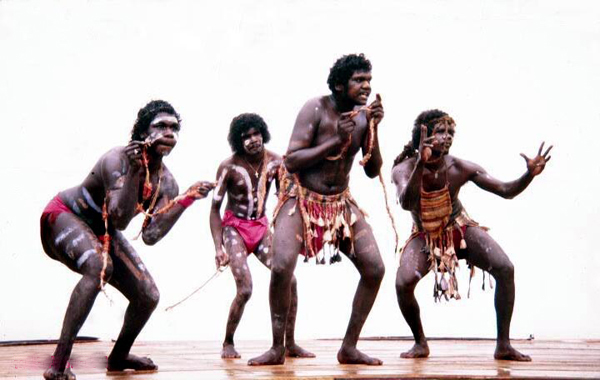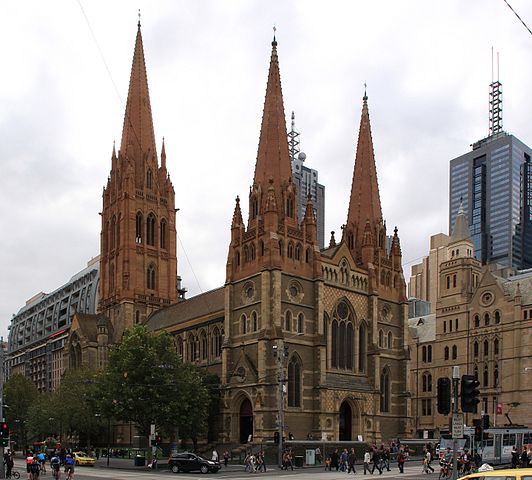CULTURE

Food
Australian cuisine is the food and cooking practices of Australia and its inhabitants. As a modern nation of large-scale immigration, Australia has absorbed culinary contributions and adaptations from various cultures around the world, including British, European, Asian and Middle Eastern.

Art
Australia has over 100,000 Aboriginal rock art sites, and traditional designs, patterns and stories infuse contemporary Indigenous Australian art, "the last great art movement of the 20th century" according to critic Robert Hughes

Dance
Traditional Aboriginal Australian dance was closely associated with song and was understood and experienced as making present the reality of the Dreamtime. In some instances, they would imitate the actions of a particular animal in the process of telling a story

Religion
Religion in Australia is diverse. Section 116 of the Constitution of Australia of 1901 prohibits the Commonwealth government from establishing a church or interfering with the freedom of religion.
TOURIST PLACES

Sydney Opera House
The Sydney Opera House is a multi-venue performing arts centre on Sydney Harbour located in Sydney, New South Wales, Australia. It is one of the 20th century's most famous and distinctive buildings.

Uluru
Uluru , also known as Ayers Rock and officially gazetted as Uluru / Ayers Rock, is a large sandstone rock formation in the southern part of the Northern Territory in Australia. It lies 335 km (208 mi) south west of the nearest large town, Alice Springs.

Great Barrier Reef
The Great Barrier Reef is the world's largest coral reef system composed of over 2,900 individual reefs and 900 islands stretching for over 2,300 kilometres over an area of approximately 344,400 square kilometres. The reef is located in the Coral Sea, off the coast of Queensland, Australia.

Bondi Beach
Bondi Beach is a popular beach and the name of the surrounding suburb in Sydney, New South Wales, Australia. Bondi Beach is located 7 km (4 mi) east of the Sydney central business district, in the local government area of Waverley Council, in the Eastern Suburbs. It has a population of 11,656 residents. Bondi, North Bondi, and Bondi Junction are neighbouring suburbs. Bondi Beach is one of the most visited tourist sites in Australia.
SEASON

Spring
Australia’s spring is characterised by sunny days and cool nights. Jacarandas and wildflowers are in bloom, creating a spectacular display of colour in many of the country’s cities, such as Canberra and Sydney, as well as in regional areas around Perth.

Summer
Summer in Australia falls between the months of December and February. It brings sunny, warm days that are best spent at one of the country’s gorgeous beaches

Autumn
The country transform from lush green to brilliant hues of orange, red, ochre and gold as the temperatures cool in autumn. It's particularly vibrant in Victoria's High Country, the Grampians and in Cradle Mountain-Lake St Clair National Park in Tasmania.

Winter/Cold Season
Widely known for its red outback and golden sand beaches, many visitors are surprised to learn that a white winter is common in Australia. The Australian Alps, in the south of the country, are home to great ski fields for winter sports and après enthusiasts.
FESTIVALS

Vivid Sydney
Vivid Sydney is an annual festival of light, music and ideas, held in Sydney. It includes outdoor immersive light installations and projections, performances by local and international musicians, and an ideas exchange forum featuring public talks and debates with leading creative thinkers.

Australia Day
Australia Day is the official national day of Australia. Observed annually on 26 January, it marks the 1788 landing of the First Fleet at Sydney Cove and raising of the Union Flag by Arthur Phillip following days of exploration of Port Jackson in New South Wales..

Mardi Gras
Mardi Gras , or Fat Tuesday, refers to events of the Carnival celebration, beginning on or after the Christian feasts of the Epiphany (Three Kings Day) and culminating on the day before Ash Wednesday, which is known as Shrove Tuesday. Mardi Gras is French for "Fat Tuesday", reflecting the practice of the last night of eating rich, fatty foods before the ritual Lenten sacrifices and fasting of the Lenten season.

Anzac Day
Anzac Day is a national day of remembrance in Australia and New Zealand that broadly commemorates all Australians and New Zealanders "who served and died in all wars, conflicts, and peacekeeping operations" and "the contribution and suffering of all those who have served". Observed on 25 April each year, Anzac Day was originally devised to honour the members of the Australian and New Zealand Army Corps (ANZAC) who served in the Gallipoli Campaign, their first engagement in the First World War (1914–1918).